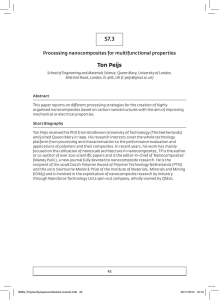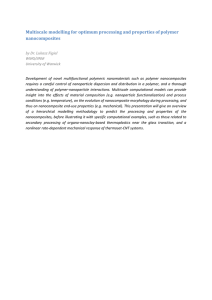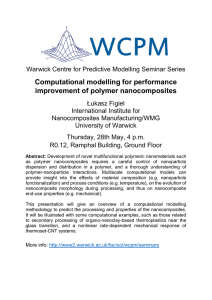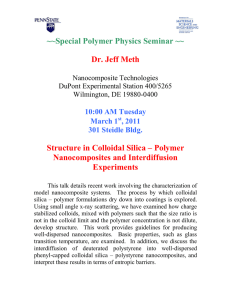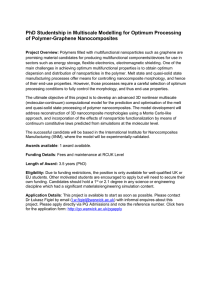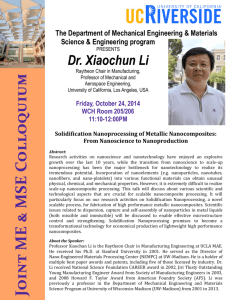A Study of the Effect of Surfactants on the Properties
advertisement
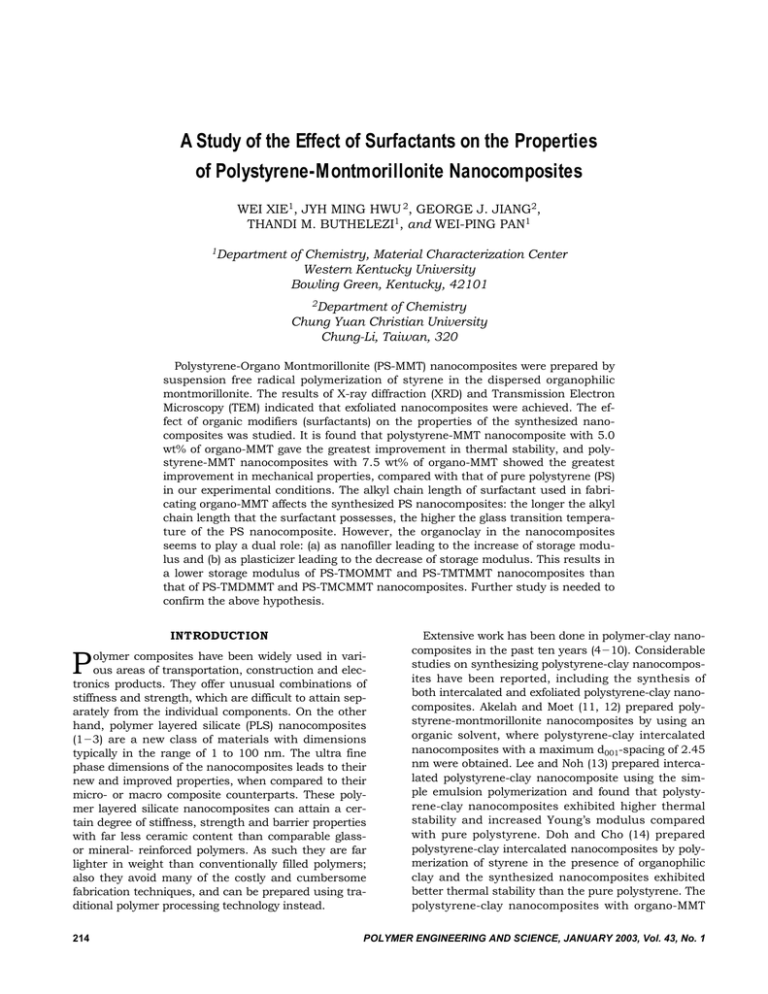
A Study of the Effect of Surfactants on the Properties of Polystyrene-Montmorillonite Nanocomposites WEI XIE1, JYH MING HWU 2, GEORGE J. JIANG2, THANDI M. BUTHELEZI1, and WEI-PING PAN1 1Department of Chemistry, Material Characterization Center Western Kentucky University Bowling Green, Kentucky, 42101 2Department of Chemistry Chung Yuan Christian University Chung-Li, Taiwan, 320 Polystyrene-Organo Montmorillonite (PS-MMT) nanocomposites were prepared by suspension free radical polymerization of styrene in the dispersed organophilic montmorillonite. The results of X-ray diffraction (XRD) and Transmission Electron Microscopy (TEM) indicated that exfoliated nanocomposites were achieved. The effect of organic modifiers (surfactants) on the properties of the synthesized nanocomposites was studied. It is found that polystyrene-MMT nanocomposite with 5.0 wt% of organo-MMT gave the greatest improvement in thermal stability, and polystyrene-MMT nanocomposites with 7.5 wt% of organo-MMT showed the greatest improvement in mechanical properties, compared with that of pure polystyrene (PS) in our experimental conditions. The alkyl chain length of surfactant used in fabricating organo-MMT affects the synthesized PS nanocomposites: the longer the alkyl chain length that the surfactant possesses, the higher the glass transition temperature of the PS nanocomposite. However, the organoclay in the nanocomposites seems to play a dual role: (a) as nanofiller leading to the increase of storage modulus and (b) as plasticizer leading to the decrease of storage modulus. This results in a lower storage modulus of PS-TMOMMT and PS-TMTMMT nanocomposites than that of PS-TMDMMT and PS-TMCMMT nanocomposites. Further study is needed to confirm the above hypothesis. INTRODUCTION P olymer composites have been widely used in various areas of transportation, construction and electronics products. They offer unusual combinations of stiffness and strength, which are difficult to attain separately from the individual components. On the other hand, polymer layered silicate (PLS) nanocomposites (13) are a new class of materials with dimensions typically in the range of 1 to 100 nm. The ultra fine phase dimensions of the nanocomposites leads to their new and improved properties, when compared to their micro- or macro composite counterparts. These polymer layered silicate nanocomposites can attain a certain degree of stiffness, strength and barrier properties with far less ceramic content than comparable glassor mineral- reinforced polymers. As such they are far lighter in weight than conventionally filled polymers; also they avoid many of the costly and cumbersome fabrication techniques, and can be prepared using traditional polymer processing technology instead. 214 Extensive work has been done in polymer-clay nanocomposites in the past ten years (410). Considerable studies on synthesizing polystyrene-clay nanocomposites have been reported, including the synthesis of both intercalated and exfoliated polystyrene-clay nanocomposites. Akelah and Moet (11, 12) prepared polystyrene-montmorillonite nanocomposites by using an organic solvent, where polystyrene-clay intercalated nanocomposites with a maximum d001-spacing of 2.45 nm were obtained. Lee and Noh (13) prepared intercalated polystyrene-clay nanocomposite using the simple emulsion polymerization and found that polystyrene-clay nanocomposites exhibited higher thermal stability and increased Young’s modulus compared with pure polystyrene. Doh and Cho (14) prepared polystyrene-clay intercalated nanocomposites by polymerization of styrene in the presence of organophilic clay and the synthesized nanocomposites exhibited better thermal stability than the pure polystyrene. The polystyrene-clay nanocomposites with organo-MMT POLYMER ENGINEERING AND SCIENCE, JANUARY 2003, Vol. 43, No. 1 Study of the Effect of Surfactants containing benzyl-units similar to styrene show a higher thermal stability than other PS-organo MMT nanocomposites. This indicates that the structure and properties of surfactant used in fabrication of organoMMT could play a very important role in determining the properties of the final polymer-clay nanocomposites. The intercalated PS-clay nanocomposites were also achieved via in situ intercalative free-radical polymerization by Okamoto et al. (15); these materials had higher storage modulus and Tg compared to pure polystyrene. Furthermore, a extended study on both thermal and fire properties of polystyrene-clay nanocomposite conducted by Wilkie et al. (16) showed enhanced thermal stability even when as little as 0.1% of clay was added. On the other hand, the successful synthesis of the exfoliated polystyrene-clay nanocomposites is also reported (1719). Fu and Qutubuddin (17) synthesized a new surfactant, vinylbenzyldimethyldodecyl ammonium chloride for intercalation montmorillonite, and reported that exfoliated polystyreneclay nanocomposites were achieved. One interesting observation from a recent study by Brittain et al. (19) is the collapse of the exfoliated structure after the nanocomposites are processed at elevated temperatures if a nonfunctional cationic surfactant was used. However, the exfoliated structure remained stable during melt processing for nanocomposites prepared using surfactants that produced tethered polymer chains. In this case, a co-polymer-clay nanocomposite (polymerization of styrene and cationic comonomer) was produced rather than polymer-clay nanocomposites. The focus of this study has been on the preparation of polystyrene-clay nanocomposites by suspension polymerization of styrene monomer in the presence of organo-MMT, and on understanding the effect of the concentration of organophilic montmorillonite (MMT) on the properties of PS-clay nanocomposites and the potential effect of surfactants with different alkyl chain lengths on the properties of PS-clay nanocomposites. The proposed dual role mechanism of clay in a polymer-clay nanocomposite system is discussed. EXPERIMENTAL Material Selection Four alkyl quaternary ammonium chlorides (R3R’NCl used as received from Akzo Nobel Chemicals, Inc.), including trimethyl dodecyl ammonium chloride (TMD), trimethyl octadecyl ammonium chloride (TMO), trimethyl coco ammonium chloride (TMC), trimethyl tallow ammonium chloride (TMT), were utilized to fabricate various organically modified layered silicate (OLS) from a base Na Montmorillonite (Cloisite Na, cation exchange capacity, CEC 92 meq/100g, Southern Clay Products, Inc.). Coco and tallow quaternary ammonium surfactants are derived from natural products and are commonly utilized in commercial oranoclays. They consist of a mixture of quaternary ammonium salts with various lengths of saturated and unsaturated alkyl chains. The nominal compositions of these natural products are summarized in Table 1. Poly(vinyl alcohol) (PVA) (MW 77,000 79,000), benzyl peroxide (BPO) and styrene were obtained from Aldrich Co. Ltd. All of the above materials were used without further treatment. Synthesis of Polystyrene-Montmorillonite Nanocomposites by Suspension Polymerization The organically modified montmorillonites were prepared similar to the conventional literature procedures (20). Briefly, quaternary ammonium salt is added to a purified montmorillonite slurry, the flocculated product is removed by filtration, dried and milled. The dispersion agent of PVA was dissolved in the 400 ml deionized water at 80°C. The initiator of benzoyl peroxide (BPO) was first mixed with the styrene monomer at room temperature, and the organo-montmorillonite was then added into the mixture until well mixed. The styrene mixture was then added into the PVA solution and continued stirring. The reaction temperature was maintained at 80°C. After 8 hours of suspension polymerization, the particle products were isolated by filtration and washed with deionized water. The polystyrene-MMT nanocomposites were obtained by drying under vacuum for overnight. Material Characterization Standard wide angle X-ray diffraction data were collected on powder PS-MMT nanocomposite samples using a Thermo-ARL X ’ TRA XRD diffractometer with Cu K radiation ( 1.5418Å) at a scanning rate of 1°/min. The operating current was 40 mA, and the voltage was 45 kV. The detector scatter slit width is 0.5 mm and receiving slit width is 0.2 mm. The polymers extracted from PS-MMT nanocomposites were examined by a Waters Model 150 Gel Permeation Chromatography (GPC). Glass transition temperature (Tg) was measured on a TA2920 Modulated Differential Scanning Calorimeter (MTDSC), with a modulated amplitude 1°C every 60 seconds with a heating rate of 2°C/min to 200°C in nitrogen environment. The decomposition temperature (Td) was obtained using a TA2950 Thermogravimetric Analyzer (TGA), with a Table 1. Percent Composition of Natural Product Alkyls. n Saturated Unsaturated 8 10 12 14 15 16 17 18 14 16 18 Coco n 12.72 6 7 51 19 9 2 6 Tallow n 17.22 3 0.5 29 1 20 0.5 2 44 n: number of carbon atoms per alkyl chain,n: mean number of carbons per chain POLYMER ENGINEERING AND SCIENCE, JANUARY 2003, Vol. 43, No. 1 215 Wei Xie, Jyh Ming Hwu, George J. Jiang, Thandi M. Buthelezi, and Wei-Ping Pan heating rate of 5°C/min to 600°C in nitrogen atmosphere. The standard error, , for determination of Td is 1.5°C. The mechanical properties were examined by a TA 2980 Dynamic Mechanical Analyzer (DMA), at 1 Hz frequency with a heating rate of 5°C/min to 140°C. The microstructure of nanocomposites was imaged using a JEM-100LX, JEOL Transmission Electron Microscopy (TEM). RESULTS AND DISCUSSION The Effect of MMT Content on the Properties of PS-MMT Nanocomposite Suspension polymerization was used to synthesize polystyrene-organo montmorillonite (PS-MMT) nanocomposite. PVA is a dispersion agent, which can surround styrene, BPO and organophilic montmorillonite in the deionized water (Fig. 1). Polymerization occurs inside the PVA vacuole, and the PS-clay nanocomposite is the powder product. Figure 2 illustrates the XRD pattern of PS-TMOMMT and PS-TMCMMT nanocomposites with 5.0 wt% organo-MMT content. There are no MMT peaks identified from either PS-MMT nanocomposite, suggesting that either the MMT silicate sheets were exfoliated in PS-MMT nanocomposite or because of a much too large spacing between the layers (i.e. exceeding 8 nm in the case of ordered exfoliated structure). However, the silicate exfoliation is confirmed and supported by TEM micrographs as seen in Figs. 3a and 3b. Clearly, PS-TMOMMT (Fig. 3a) and PS-TMDMMT (Fig. 3b) nanocomposites are well dispersed, (exfoliated) although some 23 layer stacks can still be observed in TEM micrographs. The similar exfoliated structure can also be observed from PS-TMCMMT and PS-TMTMMT nanocomposites. Table 2 lists the results of PS-TMOMMT and PSTMDMMT nanocomposites containing varying amounts of organophilic montmorillonite. It is found that both the yield and activity increased with the increase of clay content in nanocomposite. However, after the organophilic montmorillonite contents increased up to 10.0%, both the yield and activity decreased. The organophilic montmorillonite content also affects the glass transition temperature (Tg) and decomposition temperature (Td) of PS-MMT nanocomposite, which will be discussed in detail in the following section. Figure 4 shows the comparison of DSC result of pure PS and PS-TMOMMT nanocomposites. The glass transition temperatures of pure PS is at 91°C. Clearly, with the increase of the clay content up to 5.0 wt%, Tg of the nanocomposites increases. However, Tg of the nanocomposite decreases to 100.8°C when the clay content increases to 7.5 wt% and continues to decrease to 92.8°C when the clay content reaches 10.0 wt%. Similar trends can be observed from DTG curve of PS and PS-TMOMMT nanocomposite illustrated in Fig. 5. PS-TMOMMT nanocomposite has a higher decomposition temperature than that of pure PS, and nanocomposite with 5.0 wt% of TMOMMT has the highest decomposition temperature among five PS-TMOMMT nanocomposites. When TMOMMT content increases further to 7.5 wt% and 10.0 wt%, the decomposition temperature decreases slightly. The same phenomenon can be found from PS-TMDMMT Fig. 1. The reaction system of PS-MMT nanocomposites through suspension polymerization. 216 POLYMER ENGINEERING AND SCIENCE, JANUARY 2003, Vol. 43, No. 1 Arbitrary Intensity Study of the Effect of Surfactants Fig. 2. XRD curves of (a) Polystyrene, and (b) PS-TMOMMT, (c) PS-TMTMMT, (d) PS-TMCMMT, (e) PS-TMDMMT with 5.0 wt% of organo-MMT. Fig. 3a. TEM image of PS-TMOMMT nanocomposite. POLYMER ENGINEERING AND SCIENCE, JANUARY 2003, Vol. 43, No. 1 217 Wei Xie, Jyh Ming Hwu, George J. Jiang, Thandi M. Buthelezi, and Wei-Ping Pan Fig. 3b. TEM image of PS-TMDMMT nanocomposite. 106% increase for PS-TMOMMT with 7.5 wt% of TMOMMT. Interestingly enough, when TMOMMT content reaches 10.0 wt%, the storage modulus decreases compared with that with 7.5 wt% TMOMMT and has only about 20% increase compared with pure PS. This may be attributed to the dispersion of organophilic clay in the PS affecting the diffusion of initiator molecules and the silicate sheets blocking the chain propagation during polymerization. The result from DMA experiments confirms the previous conclusion from MDSC and TGA experiment, where the thermal stability of nanocomposite with 10.0 wt% organophilic MMT starts to decrease. A similar trend is also observed for PSTMDMMT nanocomposites, where 24%, 164% and nanocomposites summarized in Table 2, where PS nanocomposite with 5.0 wt% TMDMMT has the best thermal property improvement under our experimental conditions. Dynamic mechanical analysis (DMA) measures the modulus (stiffness) and damping (energy dissipation) properties of materials as the materials are deformed under periodic stress. Figure 6 illustrates the temperature dependence of the storage modulus (E) for pure PS and PS-TMOMMT nanocomposites with different TMOMMT content. With increase of TMOMMT content, E increases significantly as expected. At 25°C, there is about 15% increase in storage modulus for PS-TMOMMT with 1.0 wt% of TMOMMT, and about Table 2. The Effect of Organophilic-Montmorillonite Content on the Properties of PS-Montmorillonite Nanocompositesa. ID PS-TMO-MMT MMT (%) Yieldb Act.c (%) (103) 0 1.0 2.5 5.0 7.5 10.0 82.7 93.4 92.3 89.2 88.3 78.9 2.15 2.44 2.46 2.49 2.48 2.24 PS-TMD-MMT Tg (°C) Tdd Yieldb (°C) (%) Act.c (103) Tg (°C) Tdd (°C) 91.0 100.0 102.3 102.8 100.8 92.8 404.2 417.1 420.8 425.8 420.0 412.3 82.7 93.2 92.5 89.4 88.1 80.3 2.16 2.40 2.42 2.48 2.40 2.30 91.0 92.5 94.2 94.8 92.7 89.8 404.2 412.5 418.0 421.3 420.9 420.6 400 ml, PVA 0.4 g, styrene 0.2 mole, BPO 1 103 mole, reaction temperature 80°C, reaction time 8 hrs (weight of product)/(weight of styrene weight of organoclay) cActivity (weight of product)/(mole of BPO hrs) dT maximum decomposition temperature in DTG curve d aDI-water bYield% 218 POLYMER ENGINEERING AND SCIENCE, JANUARY 2003, Vol. 43, No. 1 Study of the Effect of Surfactants Fig. 4. DSC curves of (a) Polystyrene, and PS-TMOMMT nanocomposites with different TMOMMT content (b) 1.0 wt%, (c) 2.5 wt%, (d) 5.0 wt%, (e) 7.5 wt%, ( f ) 10.0 wt%. Fig. 5. DTG curves of (a) Polystyrene, and PS-TMOMMT nanocomposites with different TMOMMT content (b) 1.0 wt%, (c) 2.5 wt%, (d) 5.0 wt%, (e) 7.5 wt%, (f) 10.0 wt%. POLYMER ENGINEERING AND SCIENCE, JANUARY 2003, Vol. 43, No. 1 219 Wei Xie, Jyh Ming Hwu, George J. Jiang, Thandi M. Buthelezi, and Wei-Ping Pan Fig. 6. DMA (storage modulus) curves of (a) Polystyrene, and PS-TMOMMT nanocomposites with different TMOMMT content (b) 2.5 wt%, (c) 5.0 wt%, (d) 7.5 wt%, (e) 10.0 wt%. Table 3 summarizes the comparison of properties of four PS nanocomposites. Generally, PS-TMOMMT shows the highest decomposition temperature among the four nanocomposites, and the others have the rather similar decomposition temperature examined by TGA. Not surprisingly, PS-TMOMMT has the highest glass transition temperature, and with decrease of alkyl chain length of surfactants, Tg of corresponding PS nanocomposites decreases. This indicates that PSTMOMMT has the best compatibility with polystyrene. The above trend is also confirmed by Tan Delta results from DMA experiments shown in Fig. 7, from which again PS-TMOMMT nanocomposite gives the highest Tg among the four PS nanocomposites. Interestingly enough, by examining storage modulus (Fig. 7), it is found that the four PS nanocomposites can be classified into two groups. The first group is PSTMOMMT and PS-TMTMMT with an E value around 700MPa and the other is PS-TMDMMT and PS-TMCMMT with an E value around 890MPa at 25°C. Clearly, PS nanocomposites containing organophilic 25% increase in E are observed for nanocomposites with 1.0 wt%, 7.5 wt% and 10 wt% TMDMMT, respectively. The Effect of Surfactants on the Properties of PS-MMT Nanocomposite Two other organophilic montmorillonites, TMCMMT and TMTMMT, were also employed to fabricate PS-MMT nanocomposites to understand the effect of different surfactants on the properties of the synthesized nanocomposites. PS-TMCMMT and PS-TMTMMT nanocomposites were prepared using 5.0 wt% TMCMMT and TMTMMT, and compared with PS-TMOMMT and PSTMDMMT nanocomposites. Note that the alkyl chain length of four alkyl quaternary ammonium salts used to fabricate organophilic MMT decreases in the order of TMO TMT TMC TMD. As with PS-TMOMMT nanocomposite, no feature MMT peak was shown in XRD results for the other three PS nanocomposites as illustrated in Fig. 3, indicating the exfoliated structure of all four PS-MMT nanocomposites. Table 3. The Effect of Surfactants on the Properties of PS-Montmorillonite Nanocompositesa. Properties PS-TMO-MMT PS-TMT-MMT PS-TMC-MMT PS-TMD-MMT Td (°C) Tg (°C) Storage Modulusb E (MPa) 425.8 102.8 709.1 423.1 95.7 686.7 422.0 94.9 896.0 421.3 94.8 887.3 aOrgano-MMT bStorage 220 content is 5.0 wt% Modulus (E): measured at 25°C POLYMER ENGINEERING AND SCIENCE, JANUARY 2003, Vol. 43, No. 1 Study of the Effect of Surfactants Fig. 7. Comparison of DMA results of (a) PS-TMDMMT, (b) PS-TMCMMT, (c) PS-TMTMMT, and (d) PS-TMOMMT nanocomposites with 5.0 wt% organo-MMT. MMT fabricated with shorter alkyl chain length surfactants (TMD and TMC) show a higher storage modulus value than those fabricated with relatively longer alkyl chain length surfactants (TMO and TMT). To understand whether it is the molecular weight difference that leads to the different storage modulus results, the obtained PS-MMT nanocomposites were extracted with tetrahydrofuran (THF) for 24 hours by means of Soxhlet extraction. The molecular weights and polydispersities of the extracted polymers were measured by GPC and are given in Table 4. All those Mw values exhibited by the extracted polymer are in the order of 104 g/mol and are comparable with each other. The similar Mw, Mn and Mw/Mn ratios for all four samples indicate the consistent suspension polymerization experiments in this study. Hence, it is clear that the difference in storage modulus between PS-TMOMMT, PS-TMTMMT and PS-TMDMMT, PS-TMCMMT does not result from the difference in the molecular weights of the nanocomposites. Another possibility, which could affect the storage modulus value for the composite samples, is the uniformity of the distribution of nanofillers in the polymer matrix. Theoretically, at a given temperature, higher storage modulus results from the better nanofiller dispersion. DMA results, therefore, would indicate that TMDMMT and TMCMMT have a better dispersion than that of TMOMMT and TMTMMT during suspension polymerization process. However, further examination of the results indicates the above conclusion is not correct. We used a simple, old, but effective and reliable experiment, where we took a series of cylinders, placed a known amount of organoclay on the bottom of each, and then added styrene monomer at 10:1 weight ratio to the clay, shook, and let set overnight. This experiment showed that TMOMMT and TMTMMT have much better swell-ability compared with TMDMMT and TMCMMT. It is well known that the presence of organoclay in nanocomposites greatly improves the stiffness of materials leading to a higher storage modulus. On the other hand, it is possible that these organoclays may also serve as a plasticizer in the nanocomposite, resulting in a decrease in storage modulus. Note that polystyrene is much more compatible with TMOMMT and TMTMMT and the better compatible plasticizer will improve the flexibility of Table 4. Average Molecular Weights and Polydispersities of PS-MMT Nanocomposites. Sample ID Organo-MMT Content (wt %) Mn 103 (g/mol) Mw 10 3 (g/mol) Mw /Mn PS-TMO-MMT PS-TMT-MMT PS-TMC-MMT PS-TMD-MMT 5.0 5.0 5.0 5.0 34 39 43 39 88 95 100 87 2.58 2.42 2.50 2.24 POLYMER ENGINEERING AND SCIENCE, JANUARY 2003, Vol. 43, No. 1 221 Wei Xie, Jyh Ming Hwu, George J. Jiang, Thandi M. Buthelezi, and Wei-Ping Pan material. If so, the storage modulus obtained from DMA experiments is a compromised value resulting from both raising storage modulus by the role of nanoclay as the nanofiller and decreasing storage modulus by the role of nanoclay as the plasticizer. Recall DMA results for both PS-TMOMMT and PS-TMDMMT nanocomposites with varied organoclay contents presented in the first section, where the storage modulus of nanocomposite with 10 wt% organoclay is smaller than the nanocompsite with 7.5 wt% organoclay. Considering the plasticizing effect based on the above assumption, the decrease in storage modulus could be attributed to the fact that the plasticizing effect is the dominant factor over the nanofiller effect for organoclay in the PS nanocomposite with 10.0 wt% organoclay. More investigations are necessary, for example, detailed morphology study in micro- or nano- scale and the changes in orientation of filler during the processing; these all could be factors that give scatter in the data. Nevertheless, the above hypothesis would certainly spur us on to further understanding of the role of organoclay in the fabrication of nanocomposites. CONCLUSIONS PS-MMT nanocomposites were synthesized by suspension polymerization. From XRD and TEM results, the polystyrene was exfoliated into the silicate layers, and had fine dispersion in the polystyrene matrix. The results showed that the PS-MMT nanocomposites have better thermal stability and mechanical properties than pure polystyrene material. The optimum organo-montmorillonite content to give the best improvement is 5.0 wt% for thermal stability of nanocomposite and 7.5 wt% for mechanical property in our experimental conditions. The alkyl chain length of surfactant used in fabricating organo-MMT affects the synthesized PS nanocomposites, the longer alkyl chain length the surfactant possesses, the higher glass transition temperature the synthesized PS nanocomposite has. However, the organoclay in the nanocomposites seems to have dual roles, as nanofiller to increase the storage modulus and as plasticizer to decrease the 222 storage modulus, resulting in a lower storage modulus of PS-TMOMMT and PS-TMTMMT nanocomposites than that of PS-TMDMMT and PS-TMCMMT nanocomposites. Further study is needed to confirm the above hypothesis. ACKNOWLEDGMENT The authors are grateful to Dr. Richard Vaia for technical discussions, to Dr. J. Andersland for TEM experiments and to Air Force Office of Science Research for the financial support with Grant F4962000-1-0260 and Grant F49620-01-1-0334. REFERENCES 1. E. P. Giannelis, Advanced Materials, 8(1), 29 (1996). 2. M. Alexandre and P. Dubois, Mat. Sci. Eng., 28, 163 (2000). 3. T. Pinniavaia and G. W. Beal, Polymer-Clay Nanocomposites, John Wiley and Sons, New York (2000). 4. J. F. Gerard, Modern Plastics, 28, 30 (1998). 5. S. Burnside and E. P. Giannelis, Chem. Mater., 7, 1597 (1995). 6. A. Usuki, M. Kawasumi, Y. Kojima, and A. Okada, J. Mater. Res., 8, 1174 (1993). 7. V. Mehrotra and E. P. Giannelis, Solid State Ionics, 51, 115 (1992). 8. T. Lan, P. D. Kaviratna, and T. J. Pinnavaia, Chem. Mater., 7, 2144 (1995). 9. A. Agag and T. Takeichi, Polymer, 41, 7083 (2000). 10. K. Yano, A. Usuki, and A. Okada, J. Polym. Sci.: Part A: Polym. Chem., 35, 2289 (1997). 11. A. Moet and A. Akelah, Mater. Lett., 18, 97 (1993). 12. A. Akelah and A. Moet, J. Mater. Sci., 31, 3189 (1996). 13. D.C. Lee and M. W. Noh, Polymer Bulletin, 42, 619 (1999). 14. J. G. Doh and I. Cho, Polymer Bulletin, 18, 97 (1998). 15. M. Okamoto, A. Morita, H. Taguchi, Y. H. Kim, T. Kotaka, and H. Tateyama, Polymer, 41, 3887 (2000). 16. J. Zhu and C. A. Wilkie, Polymer International, 49, 1158 (2000). 17. X. Fu and S. Qutubuddin, Mater. Letters, 42, 12 (2000). 18. X. Fu and S. Qutubuddin, Polymer, 42, 807 (2001). 19. X. Huang and W. Brittain, Macromolecules, 34, 3255 (2001). 20. R. A. Vaia, R. K. Teukolsky, and E. P. Giannelis, Chem. Mater., 6, 1017 (1994). POLYMER ENGINEERING AND SCIENCE, JANUARY 2003, Vol. 43, No. 1
